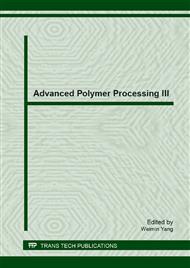p.101
p.107
p.113
p.119
p.125
p.130
p.135
p.141
p.146
Study on Structure and Properties of Polysulfone Membranes Using Ionic Liquid [n-C16mim][BF4] as a New Structure-Controlled Additive
Abstract:
Introducing ionic liquid [n-C16mim][BF4] as a new structure-controlled additive, Polysulfone (PSf) membranes were prepared by the wet-phase-inversion using [n-C16mim][BF4] into the casting solution (PSf/NMP). The scanning electron microscope and the atomic force microscopy were utilized to visualize the cross-sections of the membranes to gain more better understanding the structure-controlled ability of [n-C16mim][BF4] and surface morphologies of the membrane. The results indicate that the structures of the membranes were typical bilayer asymmetric finger-pores structure. [n-C16mim][BF4] has stronger ability of the pore-forming. Especially, at the 4:76 ratio of [n-C16mim][BF4]/NMP in the polymer solution ,the membrane has the asymmetric structure and good separation properties of the solution flux. The PSf membrane has the 0.45~0.65μm dimpling close to surface layer, and the retention rate and solution flux of the prepared membrane are 95.2% and 137.5 L•h-1•m-2. Meanwhile, [n-C16mim][BF4] partially retained in the prepared Polysulfone membrane reduced the contact angles of Polysulfone membranes, improving the hydrophilic properties of the membranes.
Info:
Periodical:
Pages:
125-129
Citation:
Online since:
July 2013
Authors:
Price:
Сopyright:
© 2013 Trans Tech Publications Ltd. All Rights Reserved
Share:
Citation:


